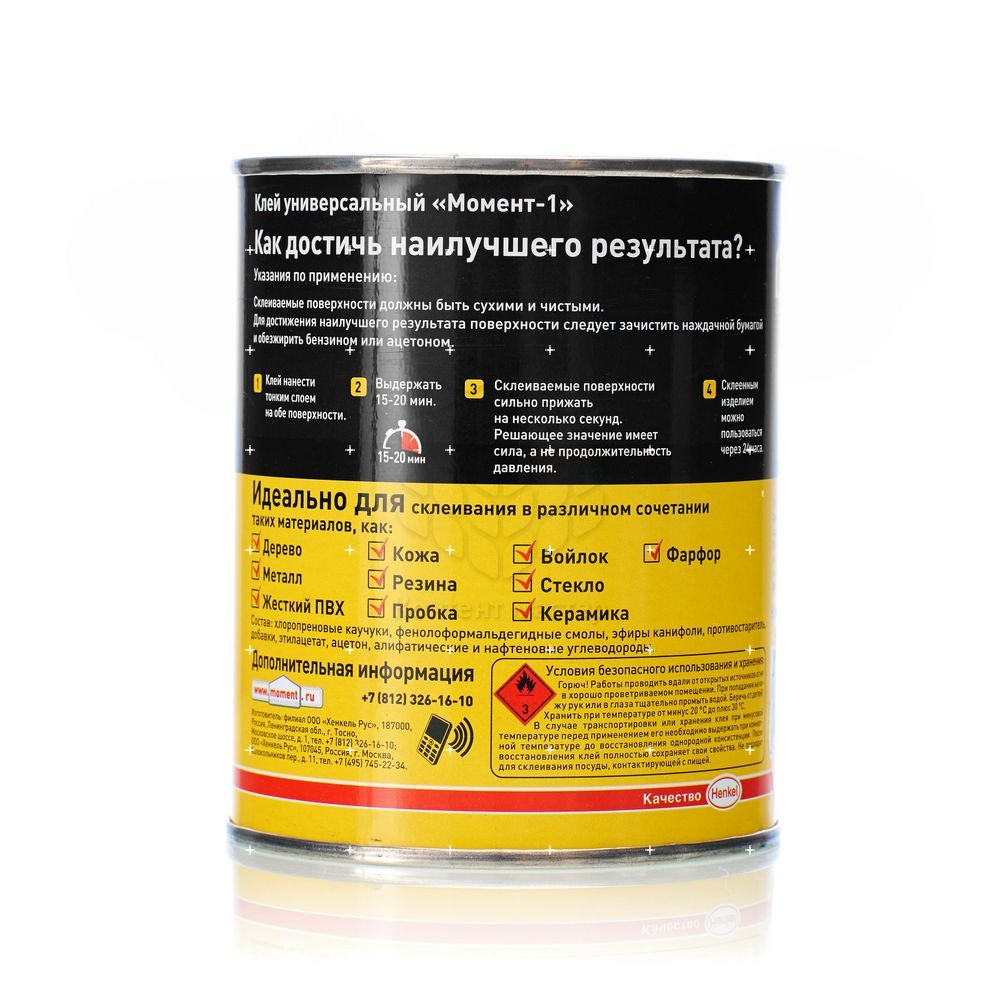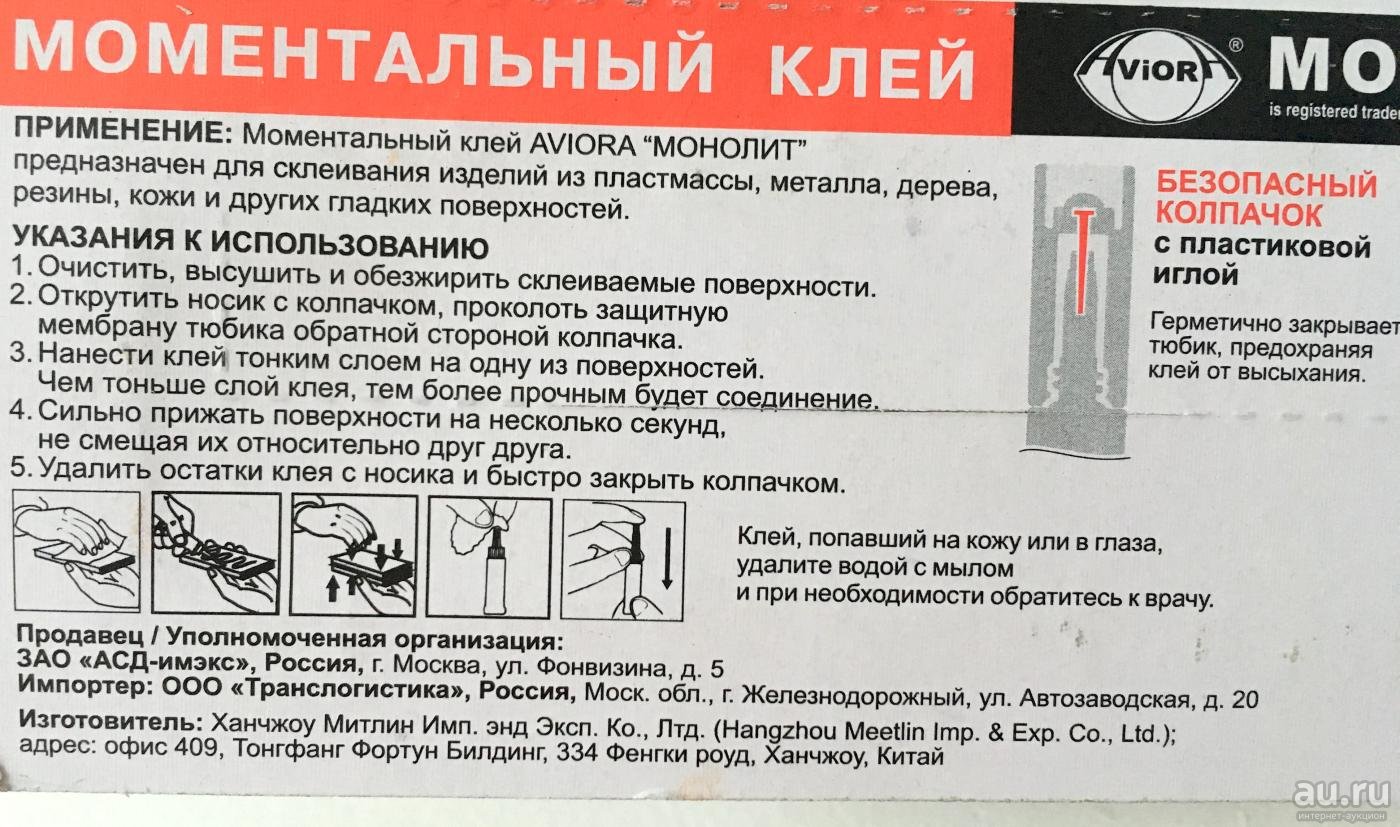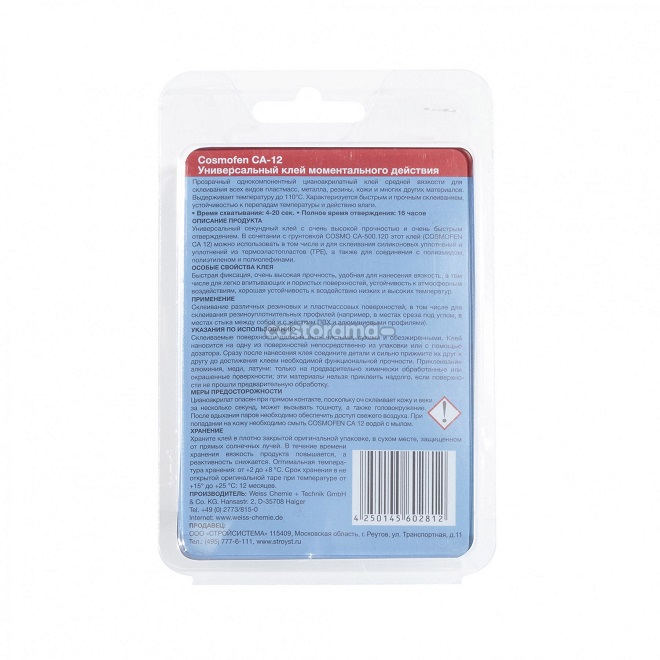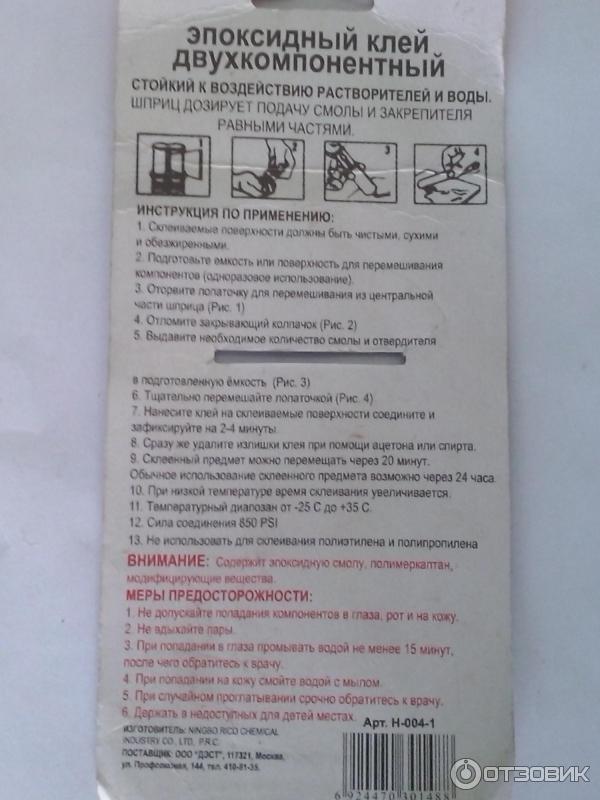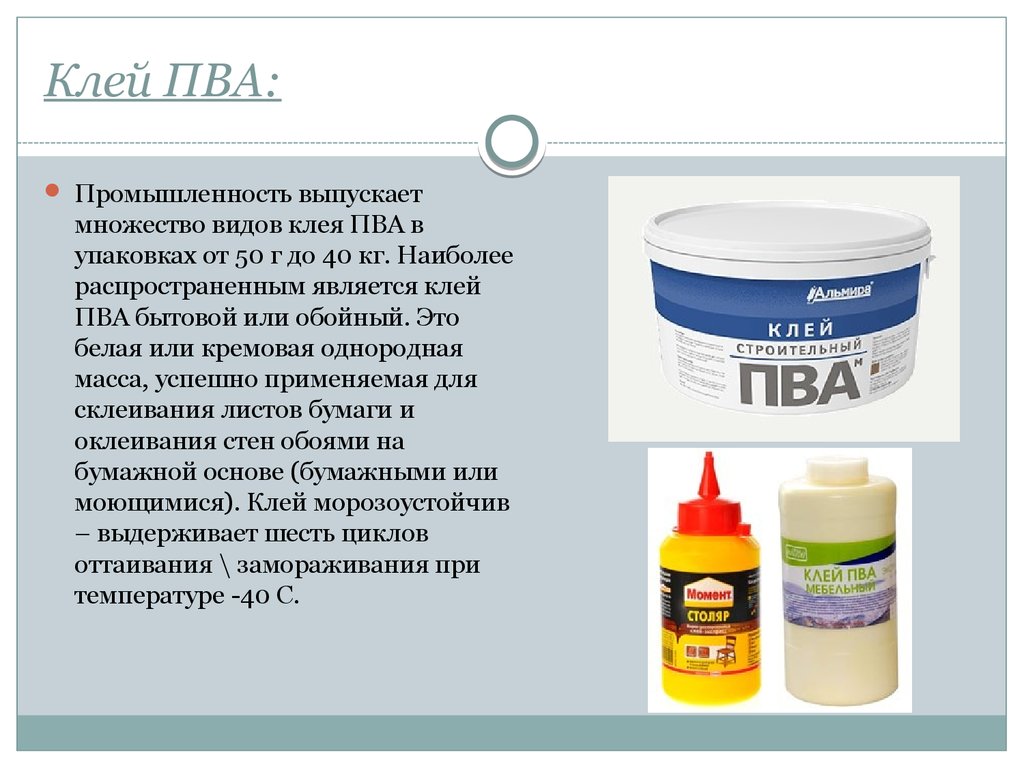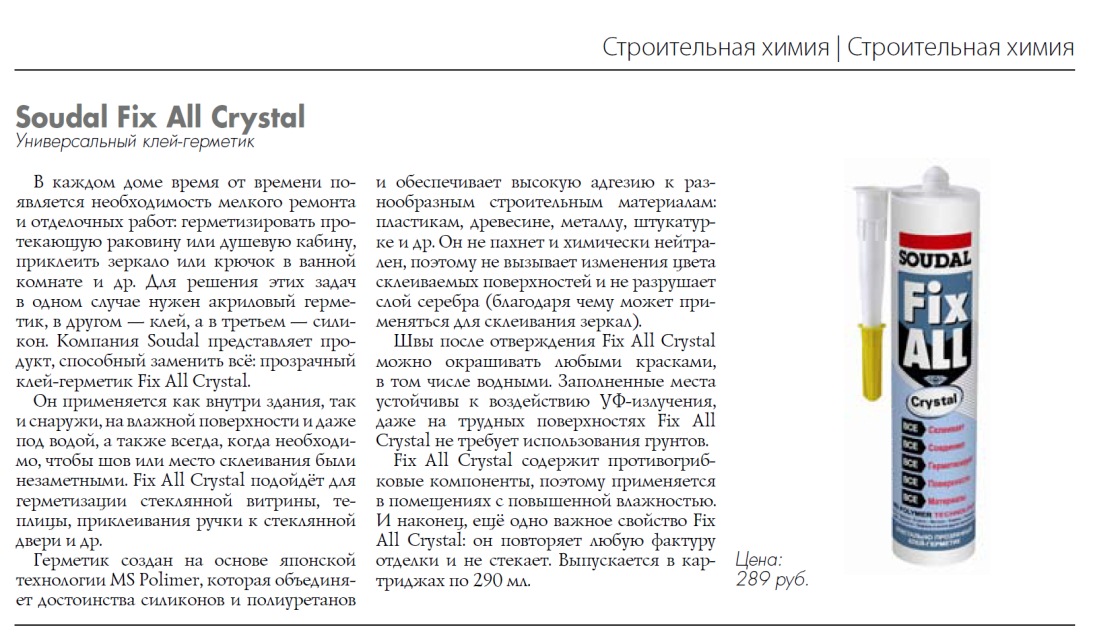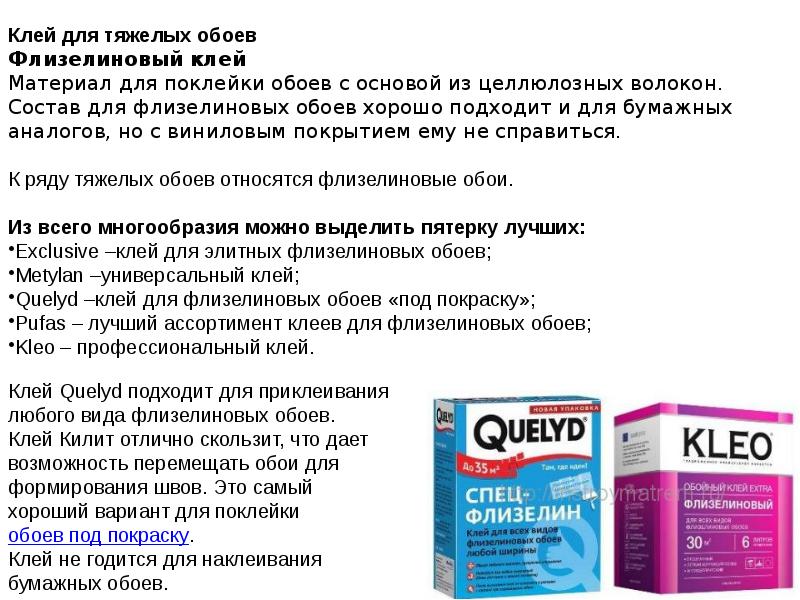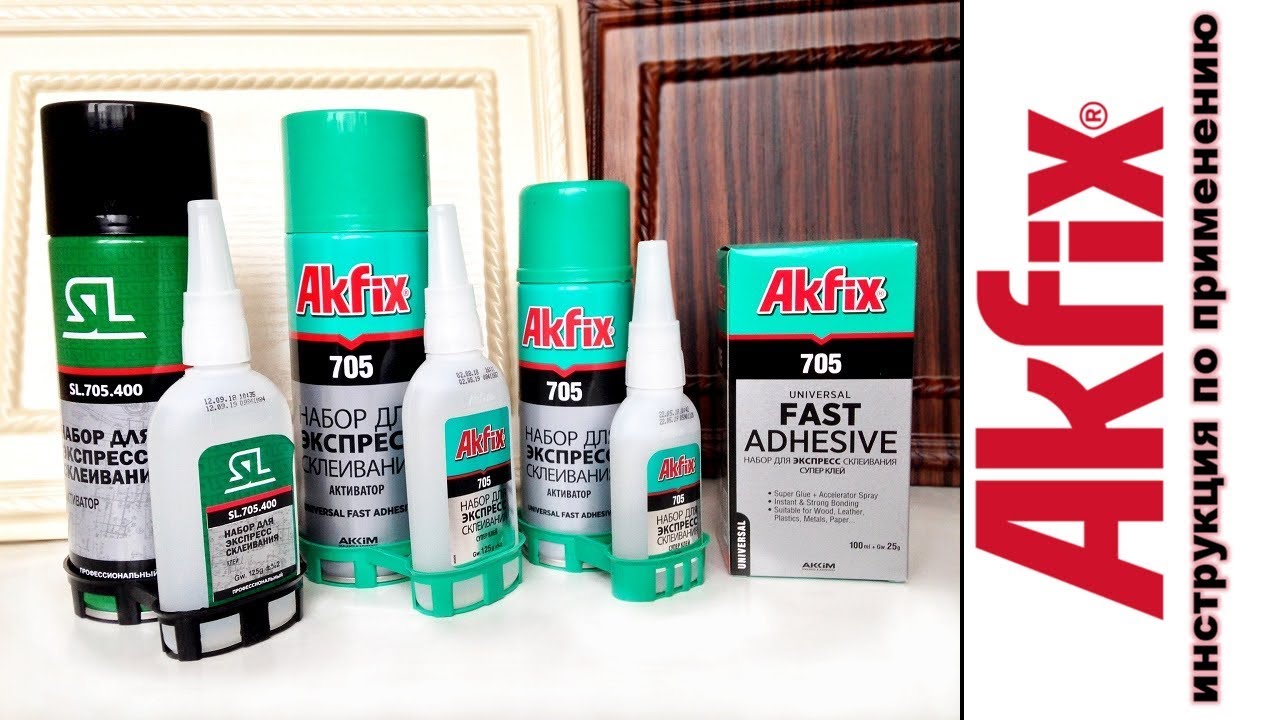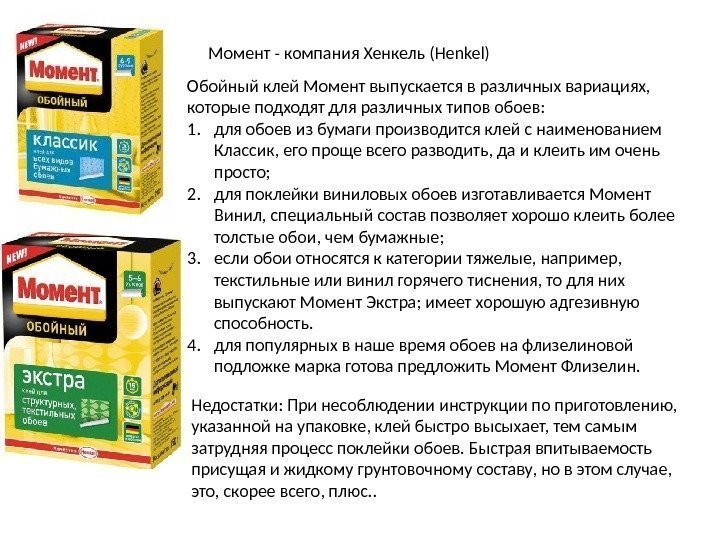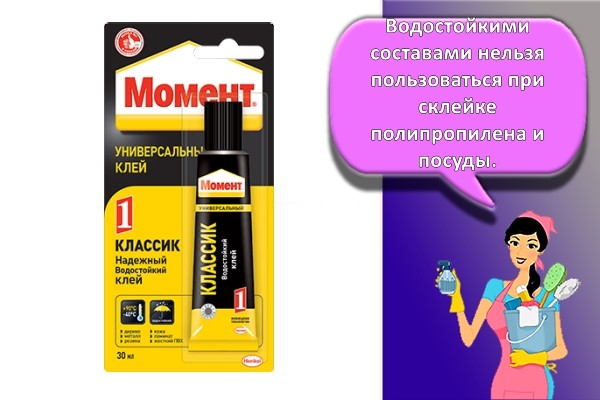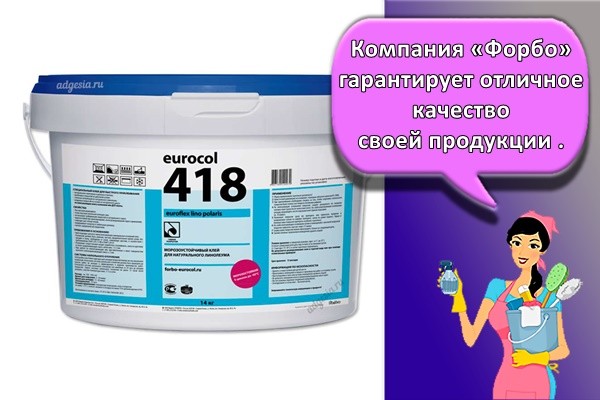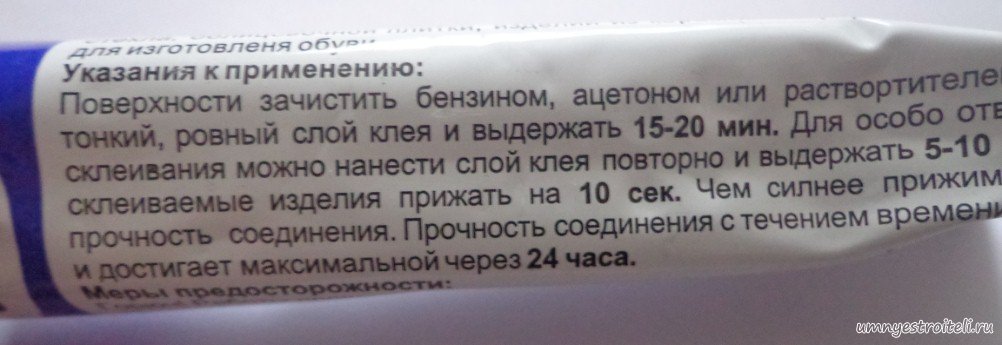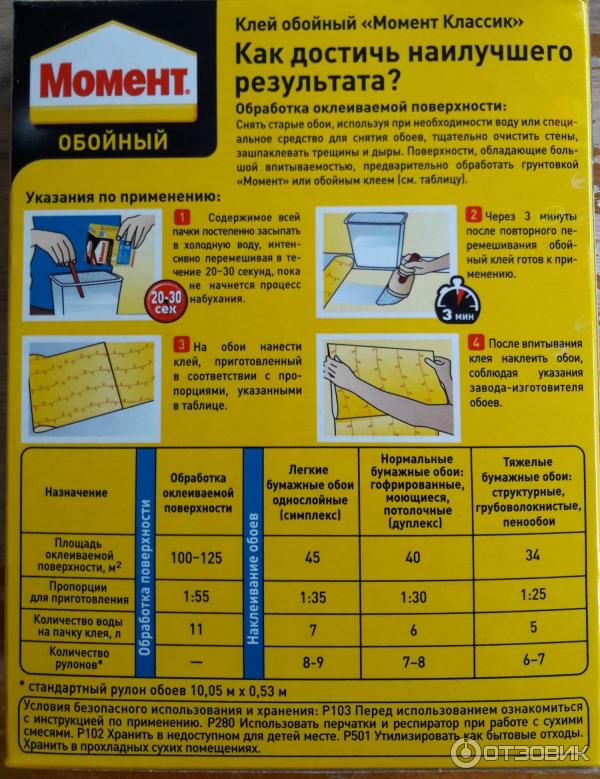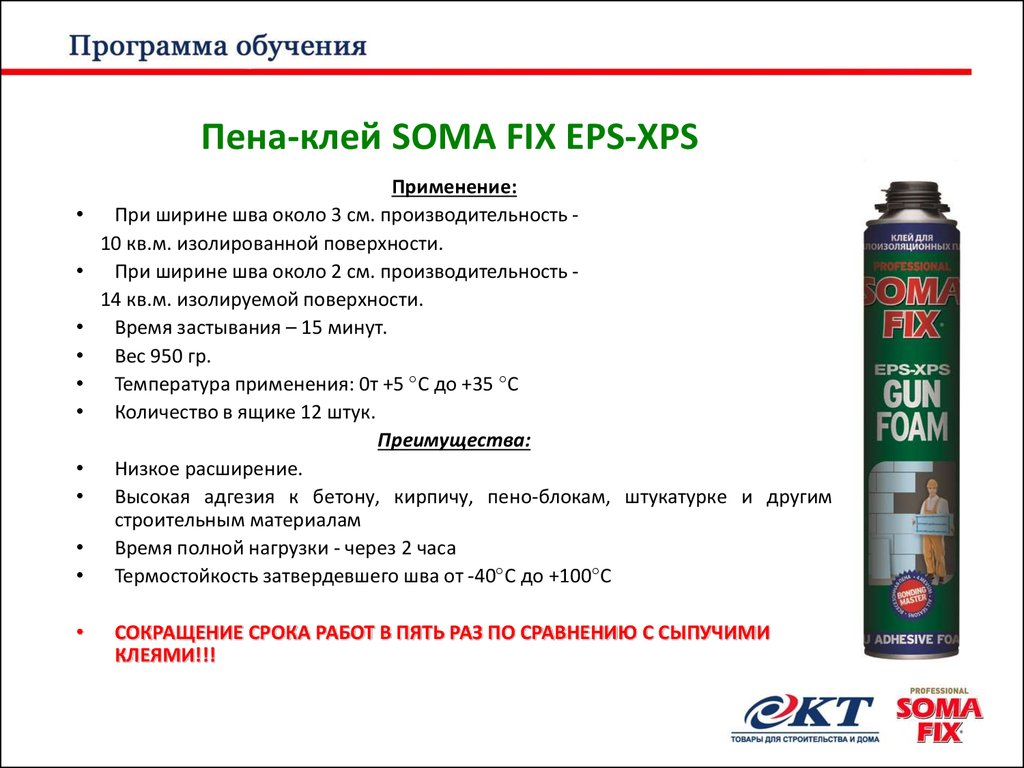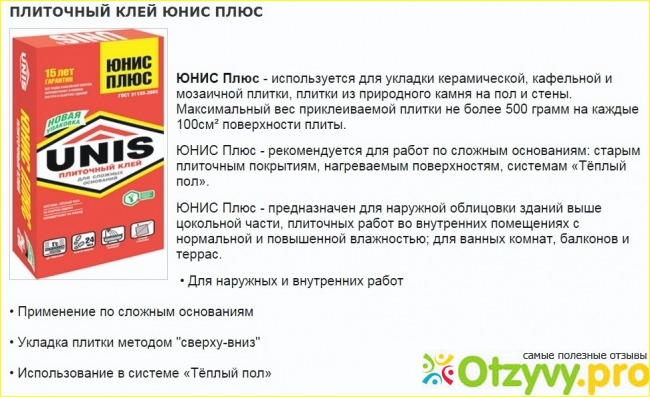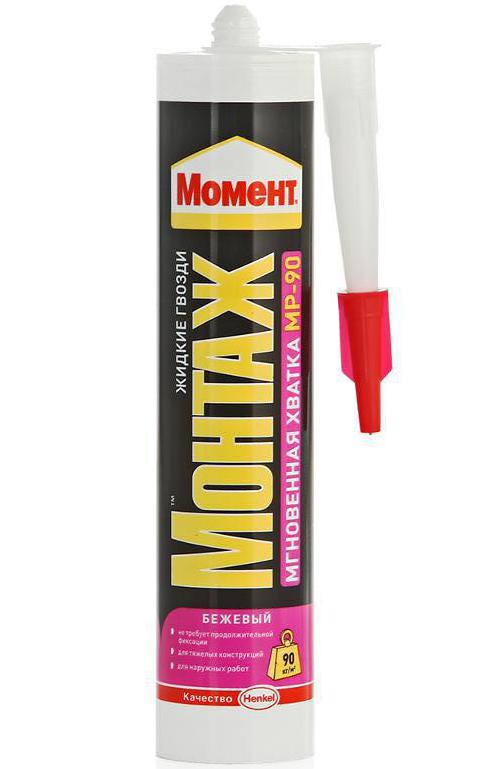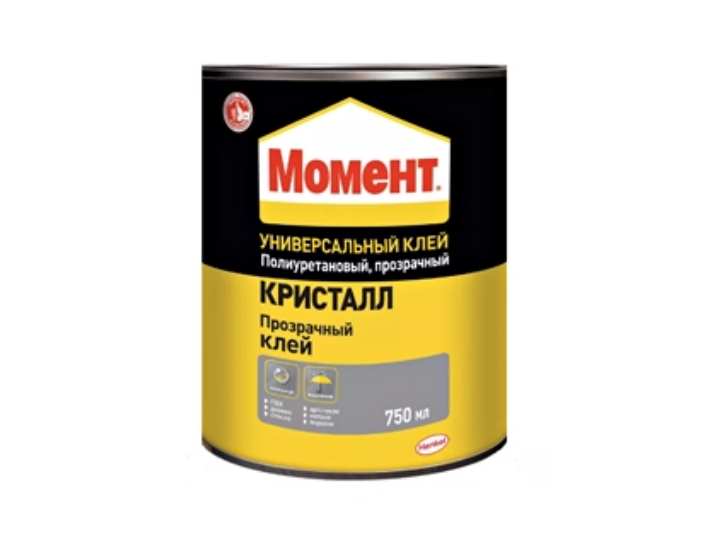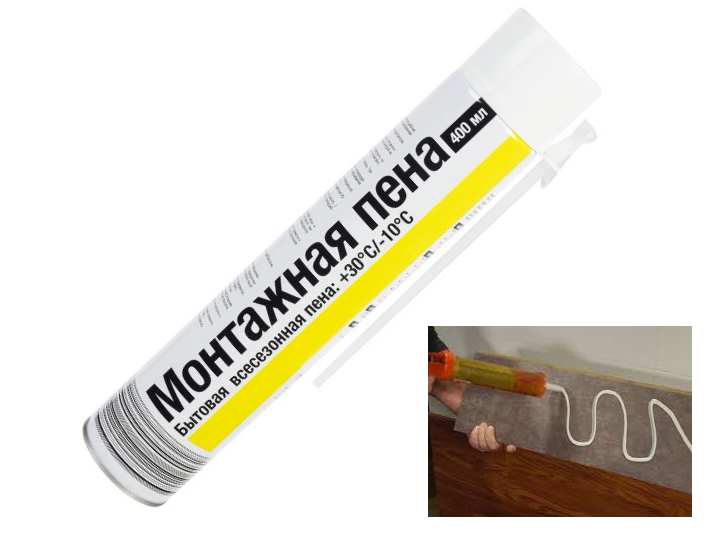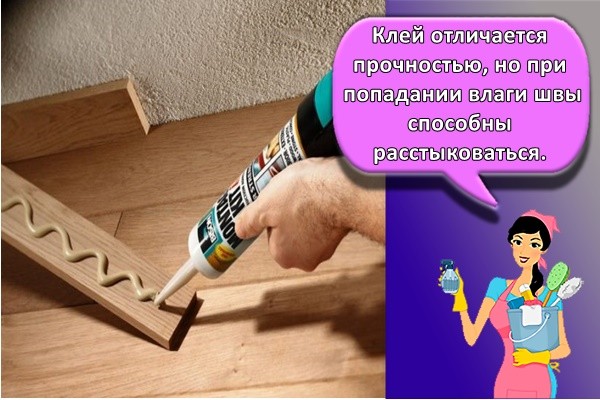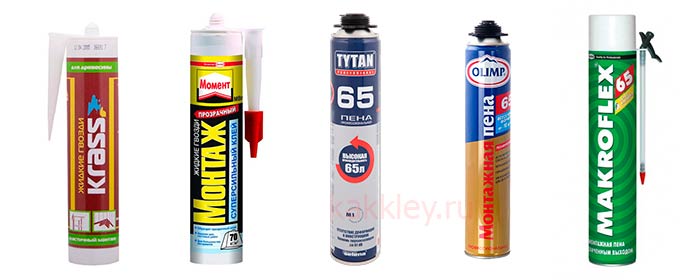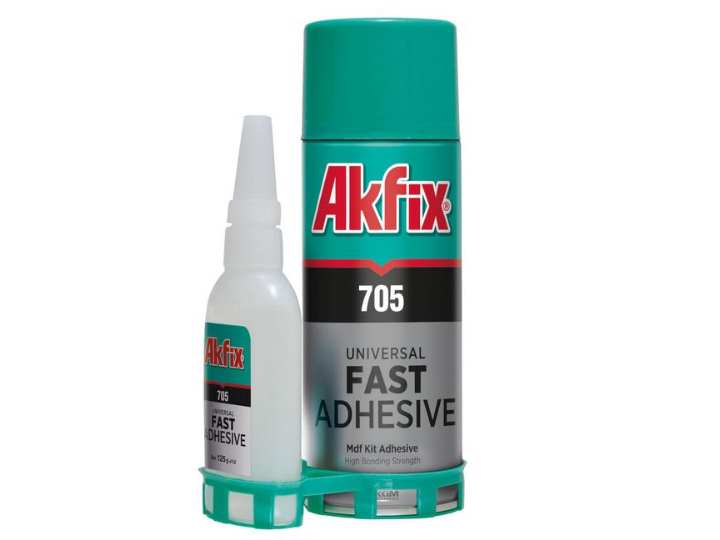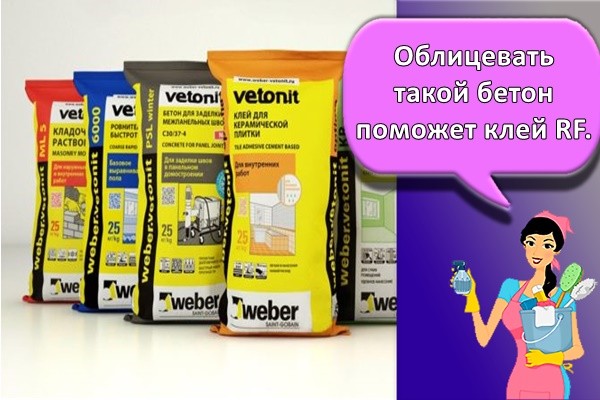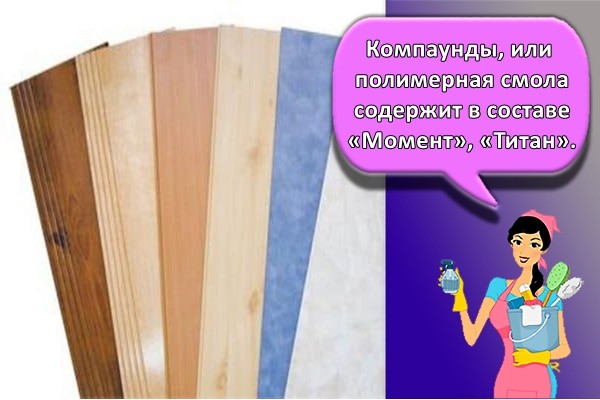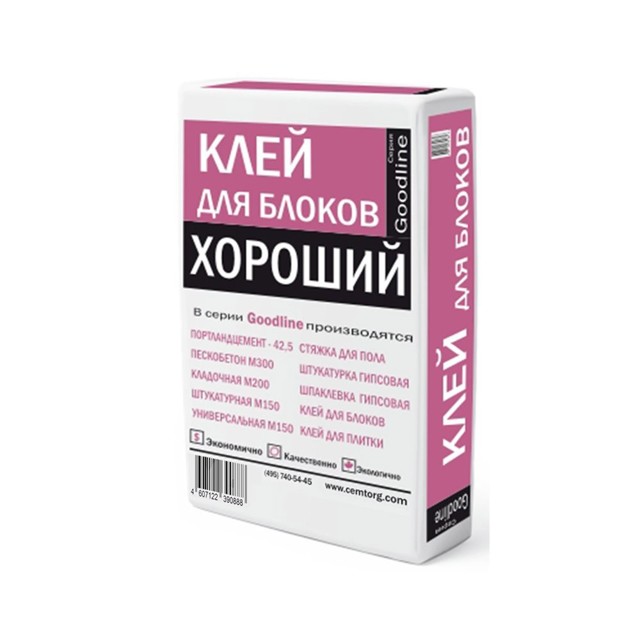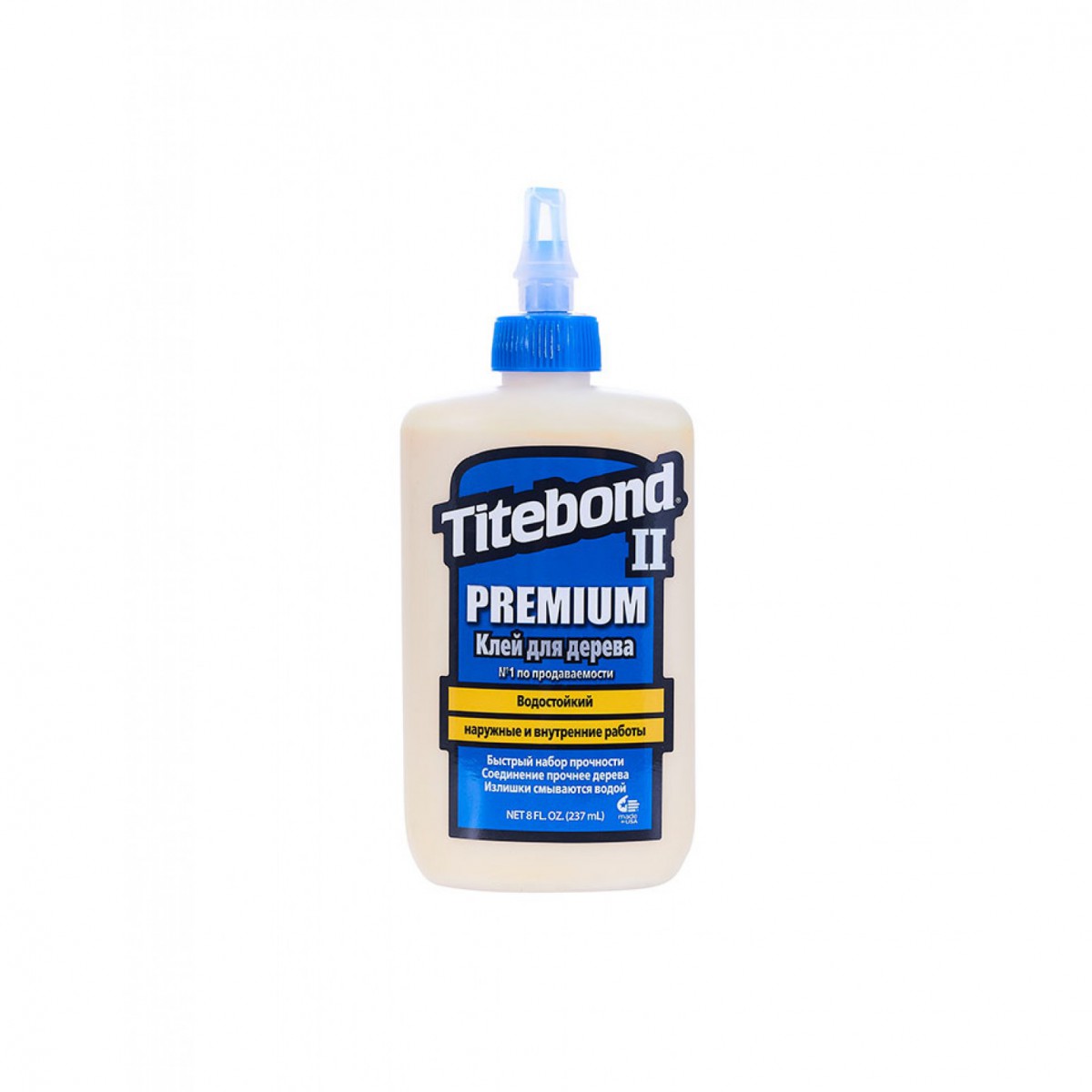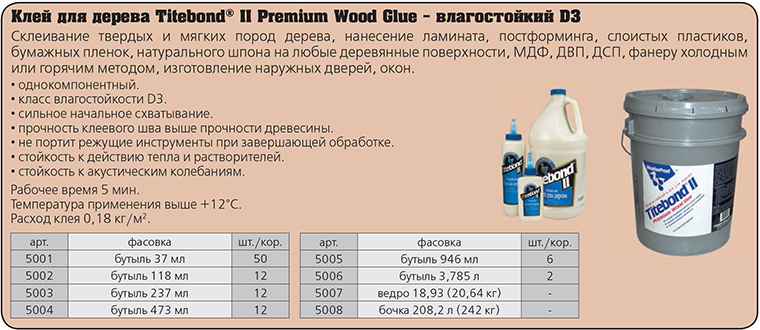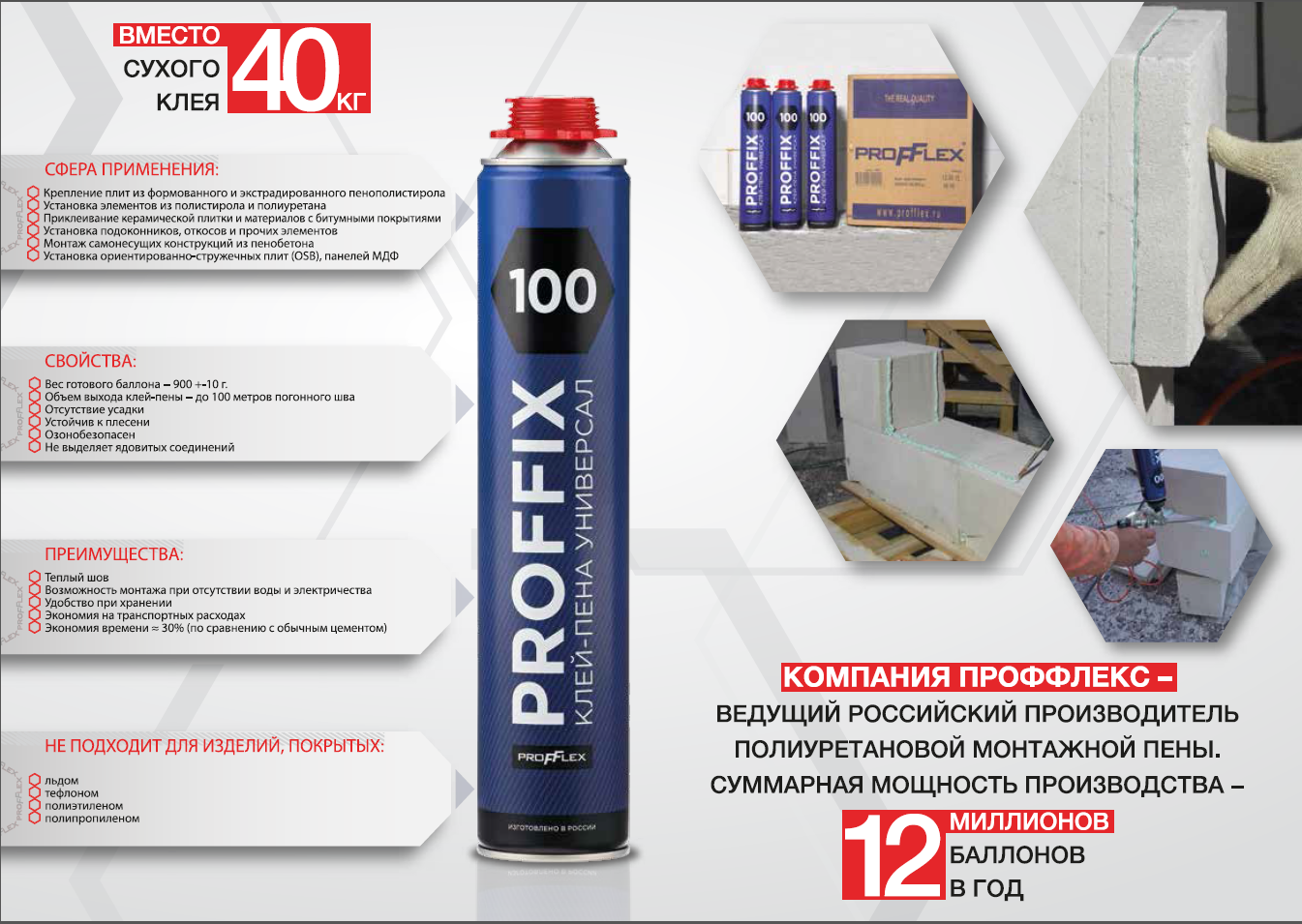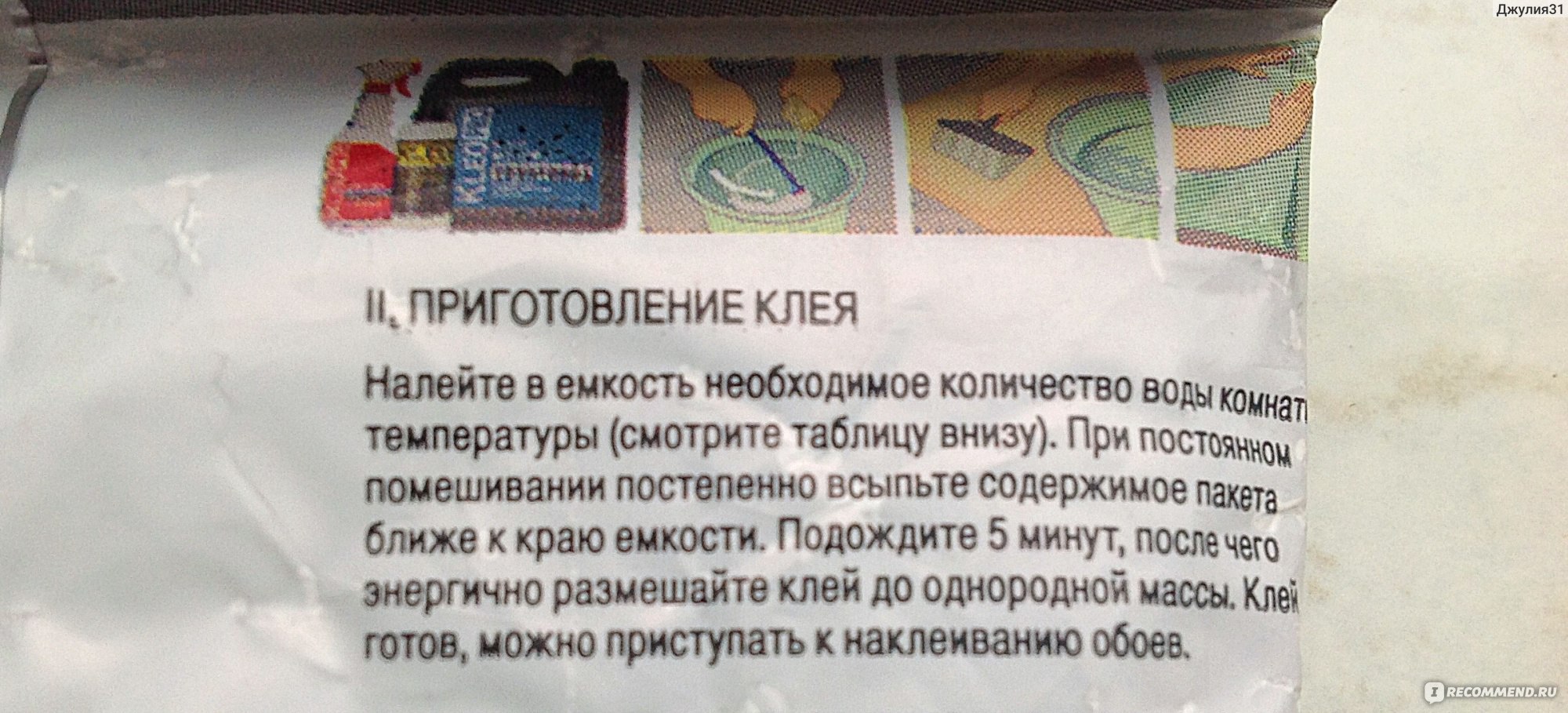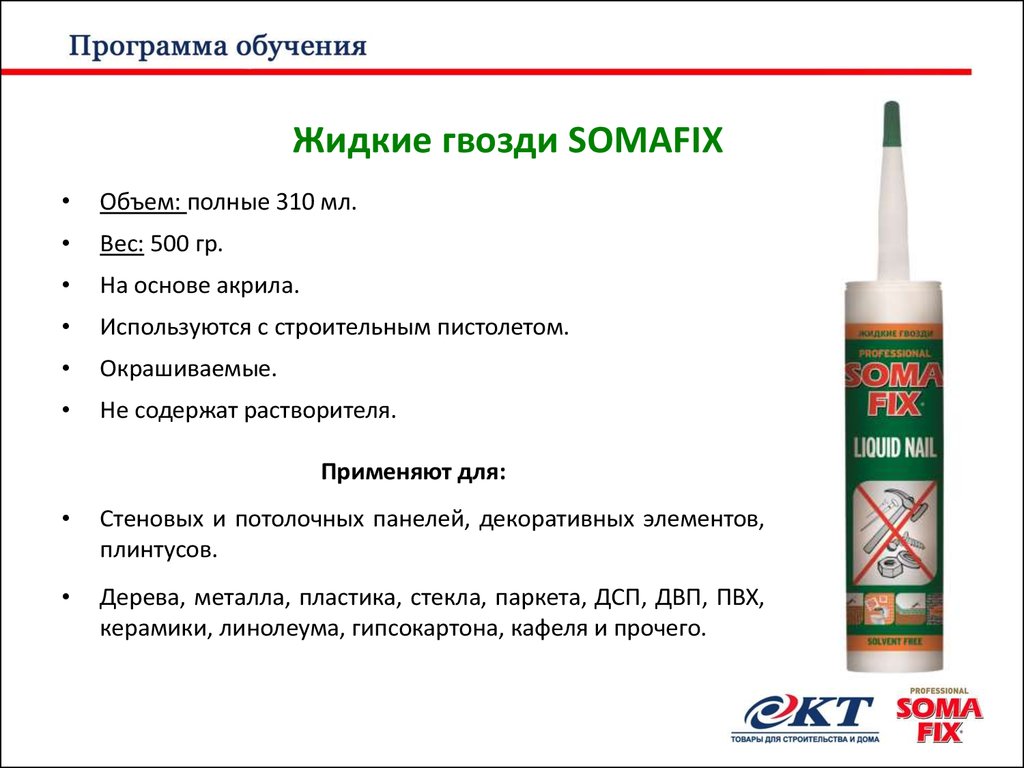Varieties
Everything is clear with the requirements, now I will move on to the specifics, and consider the products offered by manufacturers, which can be divided into three conditional groups:
Group # 1: universal compounds
They perfectly bond together heavy items made of materials such as stone, metal, glass, wood, rubber or polystyrene.
That is, they can cope with almost any fixation. Here are the most prominent representatives of this group:
- Titan Wild is used for bonding almost any building material. Its approximate price is 164 rubles per 1 liter bottle. Technical details:
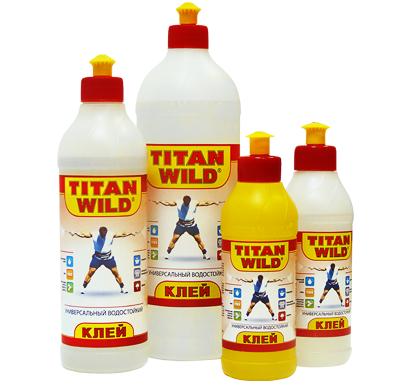
Examples of different containers of Titan Wild adhesive
- Titebond Multi-Purpose also has a very wide range of applications. Its cost starts from 130 rubles for a three hundred gram tube. Technical details:
Tube of Titebond Multi-Purpose glue
- "Moment-1". In this case, you will have to pay from 190 rubles for a jar with a capacity of 750 ml. The technical characteristics of such a composition are as follows:
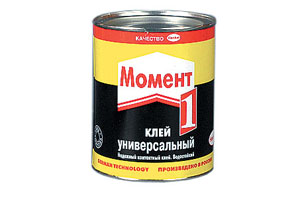
Bank with glue "Momen-1"
But before deciding on the question of what kind of glue to glue MDF panels, you should also think about your own skills in this area. So, for example, the above-described group, although it is highly effective, is not the easiest to use. So, I turn to the analysis of the following adhesives.
Tip: in the process of gluing the finish from medium density fiberboard with your own hands, be sure to take care of the presence of a draft in the room and a respirator on your face. Otherwise, you risk getting serious poisoning with toxins.
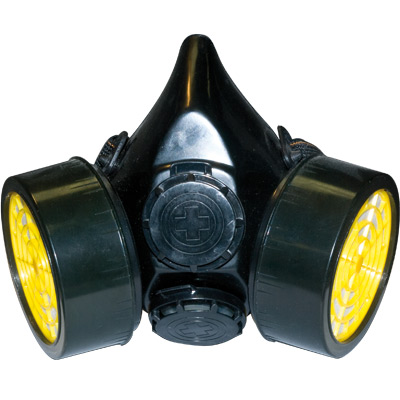
A respirator will help you bypass toxin poisoning
Group number 2: "liquid nails"
This option is especially popular among professional builders and DIYers due to its ease of use.
Advice: I recommend that when buying "liquid nails" immediately buy a special iron structure called "pistol". Thanks to this device, the application of the glue will be very simple and quick.

"Gun" for "liquid nails"
Here are the main proposals in this direction:
- Makroflex MF220 Heavy Duty. A four-hundred-gram tube costs around 158 rubles. Technical details:
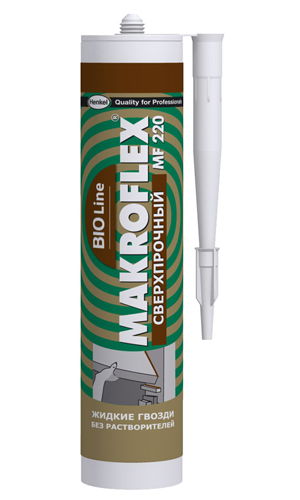
Adhesive sample "Makroflex MF220 Extra strong"
- "Liquid Nails LN-910". The price of such a composition in specialized stores is usually about 220 rubles. Technical details:
Glue sample "Liquid Nails LN-910"
- "Moment Crystal". Here a 125 ml tube costs around 110 rubles. Characteristic:
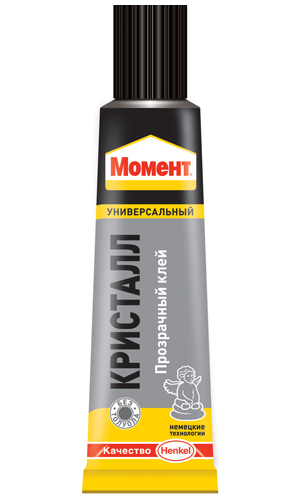
Tube with adhesive solution "Moment Crystal"
So we can safely say that "liquid nails" are an excellent answer to the question: how to glue MDF to MDF, brick, concrete or other building materials for people who deal with construction work only during home repairs.
Group No. 3: polyurethane foam
Construction foam is usually used most often to seal joints or fill voids, but experts can also adapt it for mounting medium density fiberboard sections to walls and even ceilings. As an example, consider the Orra brand:
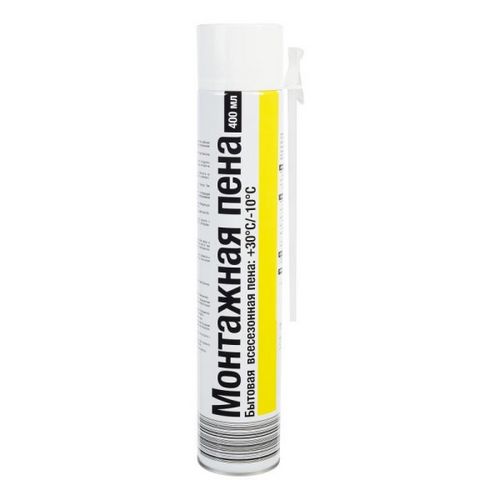
Adhesive foam for MDF panels, brand "Orra"
Installation of MDF panels on glue - instructions
Consider the technology of MDF installation using the above adhesives.
Liquid Nails
(similarly
—
universal building adhesives)
.
The thickness of the adhesive layer is only 3-5 mm, so the base on which the panels will be glued must be perfectly flat. Otherwise, the panels will repeat all the unevenness of the walls or peel off in places where they do not fit snugly.
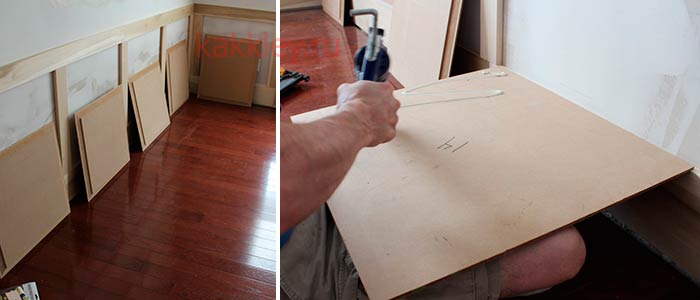
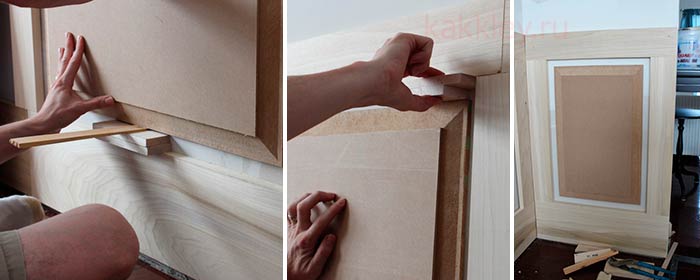
Therefore, before gluing MDF panels to the wall, it must be leveled.
- Degrease the surface, remove all impurities, putty on crumbling areas.
- Before starting work, you need to make sure that there are no irregularities using a building rule, a long level or other tool.
- The adhesive is applied in a wave-like motion or in some other way (for example, in dotted coarse drops) so that it is evenly distributed over the width and length of the panel. The pitch between the adhesive strips determines the strength with which the panel will hold onto the substrate. That is, for example, when installing in places of greatest stress, the frequency of application can be increased. Usually it is 10-15 cm. If the manufacturer determines the waiting time before gluing, it is necessary to maintain the required pause.
- With the help of a construction bubble or laser level, the start panel is installed at the desired angle (depending on the intended drawing and installation direction). The most commonly used vertical installation of panels. You should start from the corner.
- The glue on the first panel must have time to grasp the base before installing the subsequent ones (the same principle applies to other difficult junction points, for example, internal or external corners). The setting time depends on the type of adhesive (see instructions).
- Thanks to the tongue-and-groove connection, subsequent panels can be mounted without waiting (except for the waiting time before gluing).
Corners
(internal or external), as well as horizontal and vertical abutments without a groove-ridge connection are closed with decorative moldings (universal corners of MDF). Glue should be applied to the middle of each side of the decorative corner (so that when pressing down, excess glue does not come out).
Any excess glue remaining after mounting on panels is wiped off with a cloth. If the adhesive has already set, it can be carefully trimmed or abraded with abrasive paper.
The main thing is not to damage the decorative layer of the panels.
Option 2. Polyurethane foam.
The technology for installing MDF panels using construction foam is in many ways similar to the technology for installing using liquid nails or universal glue, with the only difference that the error of wall irregularities using foam can be higher due to a significant increase in foam in volume.
The waiting time before gluing the MDF panel to the substrate depends on the requirements of the foam manufacturer.
VIDEO INSTRUCTION
Basic installation errors
For liquid nails:
- Do not overexpose the glue before mounting the panel on the base. Otherwise, adhesion will be significantly lower.
- Improper application of glue - MDF panels will lose their attractive appearance if glue gets on the decorative front surface.
- Wiping off excess adhesive with a heavily damp cloth can cause the decorative coating to peel off.
For polyurethane foam:
- For gluing, foam with a low shrinkage coefficient and a professional tool should be used (high-quality guns for construction foam can smoothly and strictly dosed regulate its supply).
- If you do not wait for the setting time of the first panel, then during the movement of the subsequent ones, the foam may collapse and not fix on the base.
The question is why it is impossible to glue MDF on liquid nails
Glue "liquid nails" is distinguished by its versatility. It is suitable for mounting a wide variety of building materials. And if the list of materials to be glued includes "wood", then liquid nails are not only possible, but also must be used for gluing MDF panels.
Often, ordinary people can confuse glue "liquid nails" with sealants or silicones (they are applied using the same tool, the tube is very similar to the tube of liquid nails and in the store they can stand on the same shelf).
However, sealants for gluing MDF panels are not recommended, since their main purpose is to fix plumbing products and seal joints.
How to glue MDF - features of installation work
MDF panels are an excellent decorative finishing material, which is characterized by a high speed of installation and the absence of the need for "wet" work at all stages of finishing.
Panels also have their drawbacks (for example, MDF, like any wood, is afraid of water and high humidity, is less resistant to mechanical damage in comparison with synthetic materials, repairing damage on it is associated with a number of difficulties, etc.).
The fixing of MDF panels depends on the type of substrate and the desired result. The most common type of fastening is mechanical (on the base, a frame is often equipped with wooden or metal guides, to which MDF panels are attached using nails, screws or clamps) and chemical - using adhesives.

The latter method assumes an even monolithic base, since in this case there is no frame made of profiles or guides.
Let's start installing the frame
- 1. We note in advance that suspensions are not needed here, since this frame is assembled a little differently than the structure for drywall. Namely: along the marked line, the rail is applied to the wall and holes are drilled in the wall with a puncher right through the rail with a step of about 60 cm (as much as possible, act according to the circumstances and depending on the evenness of the rail). If the staff is uneven along the entire length, then take a smaller step for leveling.
- 2. Further, plugs are inserted into the holes in the wall, screws are inserted into the rail. The fixing of the rail begins from a predetermined place - the one that protrudes most on the surface of the wall. At this point, the rail is screwed tightly to the wall, at the remaining points it will be necessary to additionally use wedges to align the rail and maintain the plane.
- 3. After the wedges are installed, the rail is tightly fixed at the opposite end.
There is another option - fastening the frame to the wall using hangers, but there are several disadvantages. First, repair costs will increase. The second (in our opinion, more important) - the rail has a thickness of only 2 cm, when mounting on suspensions, screws need to be screwed into the end, and this will lead to the fact that each 3-4-5 self-tapping screw will split the rail and thereby reduce the strength of the entire structure. You can, of course, avoid this, having previously drilled holes for self-tapping screws in the end face, but do you need to bother yourself, and also spend time and effort on this, if you can mount the frame without suspensions? Yes, you will have to work hard and suffer with wedges, since there will be many of them and all of different thicknesses, but since professionals use this method, then apparently there are good reasons for this.
Since the slats still have to be adjusted in length, there should not be a shortage of material for the wedges, and it is even better to make them in advance - cut 5-6 cm long blocks and chop pieces of different thicknesses with a chisel. If you need to remove a couple of millimeters from the length / thickness, just trim them with a knife.
Wall decoration with MDF panels, like other repair work to level the walls, provides for the mandatory leveling of the plane already at the stage of installation of the frame. This is done as follows:
- 1. On both sides, along which the rail is located, the thread is pulled and fixed with self-tapping screws, which are screwed in to the end.
- 2. Along the edges, one match is placed under the thread. Now you can be equal to the stretched thread.
Then we turn to the installation of the frame, this process is only screwing in the remaining screws with sorting the wedges and their number. As a result, the rail should be tightly fixed and have a millimeter indent from the thread along the entire length. Next, we mount the second rail, the step is set depending on the length of the rule, the ends are set according to the level, other fasteners are set along the thread.And so on, we do the same with the rest of the slats, placing them in the same plane as the first or the previous one, while focusing on the rule.
One moment - the lowest rail must be fixed as close to the floor as possible, this will guarantee a strong connection of the panel in the lower part of the wall, in addition, there will be something to fix the plinth to after the end of the work. The same should be done with the topmost rail - attach it as close to the ceiling as possible. However, if you plan to make a suspended ceiling, then you need to start up an additional rail at the same level at which you plan to install a corner for the ceiling.
Another tip - we recommend that at the stage of installing the frame, transfer the location of the rails on the wall to paper, observing the coordinates. So in the future you can hang something on the wall, and since absolutely nothing can be attached to the panels, these records will help determine the location of the slats, which will just become the supporting structure for your paintings, lamps, and you will not have to patch up unsuccessful holes in panels.
So, we have finished with the frame, we note at last, if you need to go around the outer corners, then do everything according to the same principle, only the slats will be shorter.
Which glue to choose?
As a rule, the manufacturer of finishing materials gives recommendations on the choice of glue. Correctly chosen glue for MDF panels is a guarantee that the product will stick firmly and will serve for a long time. Generic remedies don't always live up to expectations. Although there are universal adhesives that perfectly adhere any materials.
To obtain fibers, wood is cut into small chips, which are shredded through shredders. The product began production in the 60s in the United States and arrived in Europe in the mid 70s. The thickness of the plates can vary from 3 to 60 mm, the thickest are used in structural or decorative elements of architecture and furniture.
Plywood was the first industrial wood panel. It is obtained from wood veneers bonded with urea-formaldehyde-type or phenol-formaldehyde adhesives under the action of moisture and pressure. The manufacturing process defines different types. Laminated Compensation - Produced with wood blades, usually with a pins or tip, glued and pressed to form sheets with a thickness of 4 to 20 mm. It has good mechanical strength. Condensed - The inner blades are glued in one direction and the outer plate is pressed against the other, making it more stable.
Among such station wagons, Kleyberite 636 can be distinguished. It is perfectly applied, dries very quickly, and can withstand significant loads. It contains synthetic resins. The German manufacturer gives a guarantee of product safety.
Moment Crystal is also great for gluing wall panels, including those made of MDF. It is highly moisture resistant. Not afraid of temperature changes.
Compensated multi-stage - the sheet is more stable, because in its inner part there are sheets of more or less 3 mm, glued and pressed vertically, creating a compact and more resistant to feathering. They can have a structural function and are fitted with veneers such as slippers and pins, or with decorative overlays made from essences from noble forests such as cedar, cherry, kurush and marupa. It supports nails and screws and has a density similar to that of wood.
The plates are not homogeneous, presenting three layers and have no finish; Therefore, they can receive any type of coverage. The material does not glow and does not spread flame. This solution is widely used in the production of popular furniture assembled with dowels and glue, and manufacturers do not recommend the use of nails or screws at risk of cracking. The veneer agglomerate is finished with blades of various types of wood.
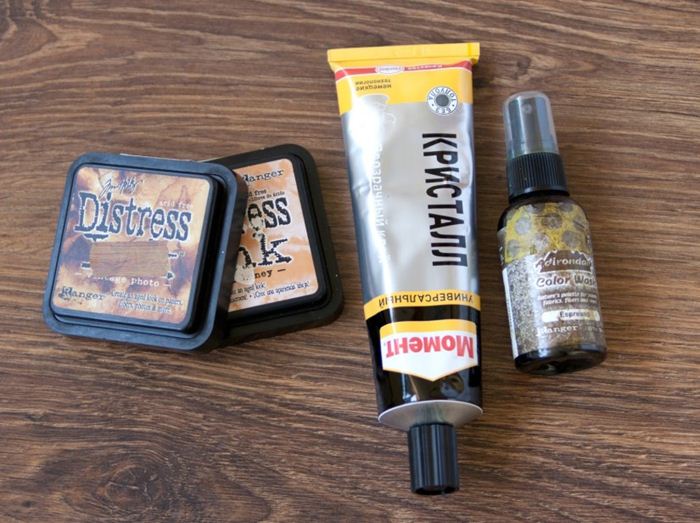
Adhesive Moment Crystal for panels
Specially designed for the installation of such a finishing material and MiterFix adhesive. By applying it, you can be sure of the durability and reliability of adhesion.
Often so-called liquid nails are used for gluing MDF panels. It is a versatile adhesive that can withstand significant breaking loads. With their help, you can even glue materials that do not fit well with each other. It is easy and convenient to work with this composition.
It is suitable for making cabinet doors, countertops, kitchen furniture, rooms and rooms that have no contact with moisture. It is a product of great mechanical stability, environmentally friendly, durable and versatile. These strips are bonded to resins applied at high temperatures and pressures.
The question is why it is impossible to glue MDF on liquid nails
Laminates fall into two categories: the difference between them is in the manufacturing process, at high or low pressure, and their durability. High pressure laminates are composed of decorative paper impregnated with melamine resin and several layers of kraft paper impregnated with phenolic resin, forming a sandwich of paper and resins. It is pressed at high temperatures and provides great durability and resistance to moisture and shock. It is commonly used in furniture covering, commercial or residential applications, flooring and walls, ceilings, partitions, stands and decorative items.
Before deciding what glue to glue the MDF panels with, you need to know by what parameters the glue is selected. The selection criteria for the adhesive mixture are:
- high adhesion strength;
- resistance to temperature changes;
- moisture resistance;
- no toxicity.
The best PVA based adhesives
PVA glue for wood is in demand in office supplies, as well as when working with wood. Such an environmentally friendly product will not leave marks, has a strong adhesion, but does not withstand moisture well. When comparing 8 products, it was found which is better. The list contains 4 of them.
Kiilto PVA D3
The product is known for its white shade, thick composition. The best glue for wood, as it is distinguished by moisture-repellent properties, is able to withstand 5 freezing cycles down to -40 degrees, while maintaining all the basic qualities. At the moment, it is produced by a large number of developers, including the Finnish brand - Kiilto.
Advantages:
- Safe, based on water dispersion;
- Packages of 1 and 3 liters are available;
- Cost-effectiveness of spending;
- Fire resistance;
- Promotes sound insulation;
- Thermal resistance.
Disadvantages:
- Need a brush or roller to use;
- It is used only at +10 degrees.
Based on the reviews, the tool will allow you to create a reliable connection that has a large temperature range. In view of this, all materials that are of wood origin are glued together.
Moment Super PVA D3 moisture resistant
Russian glue for wood Moment Super PVA D3 moisture resistant has good operating characteristics. It is used to glue various objects made of wood, veneer and materials containing wood inclusions. The product is slightly inferior to the leaders in setting duration (15-20 minutes) and complete drying (day).
PVA glue for wood will not leave marks on the material after drying. The water dispersion will retain its qualities at temperatures ranging from +5 to +30 degrees. This characteristic is indicated by buyers in responses as a minus of the product. Consumers note the reliability, transparency, availability of the considered adhesive composition.
Advantages:
- Transparency;
- Withstand static load;
- Versatility;
- High water resistance;
- There is no unpleasant odor.
Disadvantages:
- Cannot cope with dynamic load;
- Properties decrease at subzero temperatures.
Moment Super PVA D3 moisture resistant differs from analogues in a longer squeezing time (20 minutes).Complete drying will occur after a day.
PVA professional Tex Universal
Various materials can be glued with TEX PVA Joiner Professional. Among them are wood, cardboard, paper products, leather, linoleum. The adhesion strength is achieved due to the excellent adhesion. At the same time, the seam is characterized by increased reliability and elasticity.
The composition is white, which should not alarm the consumer. At the end of drying, it will become transparent, and therefore will not spoil the formed knot. Experts note the comfort at work, the absence of unpleasant odors. The adhesive composition deservedly occupies leading positions in the rating. Experts note the adhesion strength. The downside will be the high consumption of glue, it dries after 1 day.
Advantages:
- Versatility of operation;
- Non-toxic materials;
- There is no unpleasant odor;
- Comfortable packaging;
- Adequate strength.
Disadvantages:
Uneconomic waste of material.
Based on reviews, PVA Tex is a universal glue for wood. It comes in a comfortable package that is easy to use. Equipped with an ergonomic lid, the gluing process is fast and reliable.
PVA Varnish Builder universal
High quality product based on PVA water dispersion. PVA Varnish Builder universal is distinguished by increased reliability of setting, fast drying. Upon completion of the setting, a flexible, transparent film forms. The composition is recommended by experts for carpentry: glue wood objects, furniture, glue linoleum (fabric), leather goods, cardboard, paper.
Advantages:
- Perfectly glues paper, wood;
- The materials are non-toxic;
- Just wash it off;
- There is no aroma;
- Economical use.
Disadvantages:
Flammability of materials.
Based on the reviews, the adhesive is distinguished by a thick, homogeneous composition without lumps, foreign impurities.
Instructions for use and basic rules of work
Working with B7000 glue is in many ways similar to working with other formulations, below is a step-by-step plan of action:
- The temperature regime required for operation is from 18 to 32 ° C.
- The surfaces to be glued must first be cleaned of dust, remnants of old glue and other contamination, and then degreased with acetone or medical alcohol.
- The glue is applied to a dry surface in a thin layer directly from the tube, for this it has a thin metal tip.
- If the compound gets on other parts, it can be easily wiped off until it is completely cured. Excess glue from the cracks is removed with any thin and sharp object (needle or toothpick, for example). Even if it is completely hardened, the work can be redone: heat it up to at least 80 degrees, and it will lose its properties.
- It can take up to 15 minutes to set the parts, and it will take a day to completely dry.
Video instruction:
Properties and composition
UR-600 polyurethane glue is a one-component composition, that is, in this case, the active substance is not mixed with a solvent. It includes polyurethane rubber itself and additional components previously dissolved in acetone and ethyl acetate. The latter are necessary to provide the initial viscosity of the mixture.
UR-600 glue
The composition is included in the category of contact, that is, the fastening of parts begins immediately after the contact of the material and the substance. It is a colorless or milky viscous liquid that does not require additional addition of hardeners.
The composition is able, according to expert reviews, to glue a variety of materials, although it is mostly used when connecting rubber products - a boat, shoes, upholstery, and PVC materials.
However, there are other benefits:
- the composition of UR-600 is resistant to the action of alkalis, acids, gasoline, oil and water;
- the seam is exceptionally strong, but at the same time remains flexible and elastic;
- working temperature range - from -50 to +120 C. This is one of the most versatile adhesive solutions;
- Rogneda does not include narcotic components - toluene, for example;
- the product is produced ready-to-use. In the photo - UR-600 glue in a package.
Sticking tool
Review of effective brands
Among the above groups of glue, the most popular are several brands with high characteristics. According to the reviews of professionals, when choosing, it is worth giving preference to such brands.
Titan wild
Glue belongs to the group of liquid nails and is a universal professional tool. Titan wild successfully replaces fastening with screws, self-tapping screws or nails. The glue is able to fix MDF panels on any surfaces. It is used both indoors and outdoors. The advantages of the brand include:
- reliable fixation without damaging the structure of the material;
- moisture resistance - 100%;
- cost-effectiveness of spending;
- setting speed;
- the possibility of using at different temperatures.
Titebond
The glue is based on an aliphatic resin. It is used in the joinery industry for gluing wooden parts, applying laminate, MDF, chipboard, furniture assembly. The advantages of Titebond glue include:
- fast setting;
- readiness to work;
- resistant to moisture, heat, solvents;
- ensuring the strength of the adhesion boundary is much higher than that of wood.
The glue looks like a viscous yellow emulsion, after drying it is translucent. Resistant to freezing, ignites when exceeding 100 ⁰С.
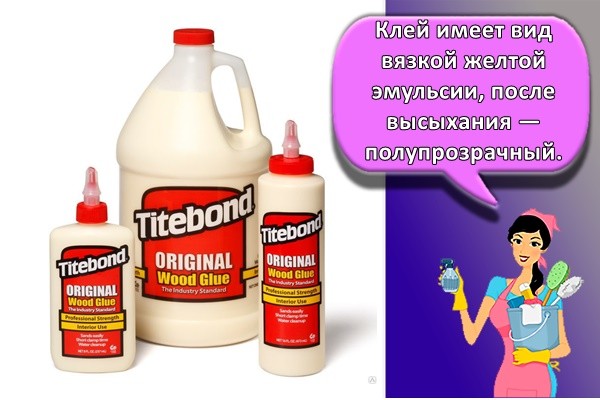
"Moment-1"
Universal glue "Moment-1" is perfect for gluing surfaces made of different materials, is moisture resistant and can withstand temperatures from -40 ⁰С to +110 ⁰С. The glue dries very quickly thanks to the components included in it:
- rubber resins;
- rosin;
- ethyl acetate;
- acetone;
- hydrocarbons.
Moment-1 glue is a light yellow thick liquid. The optimum temperature for work is from +18 ⁰С to +25 ⁰С. When fixing the panels, an air flow should be ensured so as not to get poisoned by toxins.
Tytan Euro-Line 601
Glue belongs to the type of universal construction. It is used indoors and outdoors. The base on which MDF is mounted can be made of wood, concrete, brick, plaster.
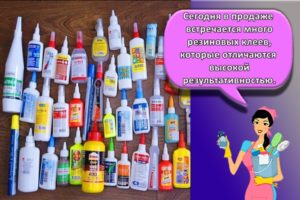
Tytan Euro-Line 601 glue is based on rubber. With the help of it, they carry out repairs and decoration with MDF panels. The main characteristics are:
- strong and fast grip;
- strength;
- hardening within 24 hours;
- temperature resistance in the range from -30 to +60
"Moment Crystal"
The glue is colorless, transparent, dries quickly and leaves no residue as a result of working with it. Liquid nails securely fix the MDF panels installed on the ceiling or walls inside the premises. Moment Crystal is well suited for gluing panels without top trim.
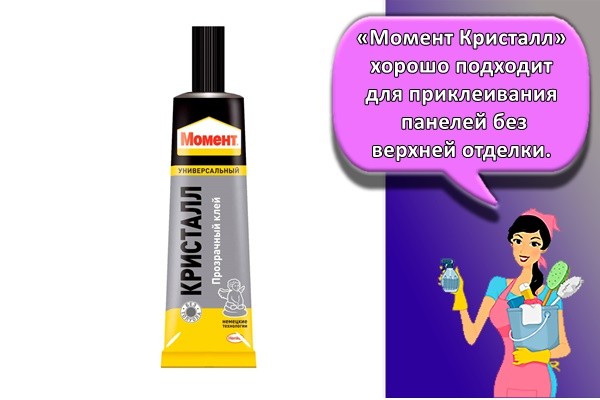
A feature of this type is that the speed and reliability of the setting depends on the force with which the surfaces were pressed. Moment Kristall is characterized by high frost and moisture resistance.
Makroflex MF220 Heavy Duty
This brand of glue is intended for joining different materials:
The form of the glue is a white paste based on polyacrylates. The optimum temperature for fixing is from +10 ⁰С and above. Among the characteristics of Makroflex:
- maximum exposure time - 15 minutes;
- lack of smell;
- the ability to use on the street and inside the house;
- high gripping force.
Liquid Nails LN-910 Panels
This brand of liquid nails is indispensable for quickly covering a room with panels, gluing decorative elements, baseboards, moldings. The adhesion is reliable if brick, concrete, wood, plywood, chipboard and other materials are used as a base.
The glue is intended for interior use. It is distinguished by a number of characteristics:
- elasticity;
- the ability to adjust the gluing within 15 minutes after connecting;
- deformation obstacle;
- long (up to 20 years) service life;
- the ability to freeze and defrost.
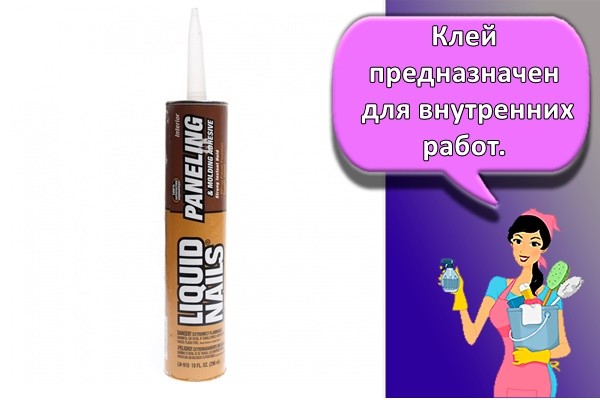
Liquid Nails LN-901 Extra Durable
The composition is based on synthetic rubber. Able to create the most durable connection in difficult conditions. Suitable for both indoor and outdoor use. Set quickly. It can be operated at temperatures from -40 ⁰С to + 70 ⁰С. The materials to be glued are used:
Temperature from -40 ° С to +70 ° С is optimal for operation, from +5 ° С to +38 ° С - for work.
What is the glue for the corners of MDF panels. What is MDF
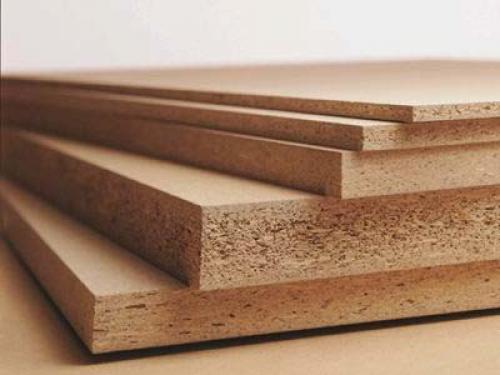 MDF is the Russian-language version of the abbreviation MDF, which stands for Medium Density Fibreboard, that is, medium density fiberboard.
MDF is the Russian-language version of the abbreviation MDF, which stands for Medium Density Fibreboard, that is, medium density fiberboard.
In the production process, dry pressing of the mass from the smallest components is used. It contains sawdust and wood shavings. In order to properly fabricate panels, the material is subjected to pressure and high temperature.
The mass is bound with the use of urea resins, which are modified with melamine. This eliminates the possibility of formaldehyde evaporation.
Since the panels are classified as environmentally friendly materials, they are allowed to be used for interior decoration. Wall panels are fastened by analogy with natural wooden clapboard. Resins and phenol are not used in the manufacturing process of building materials, which provides them with a high level of safety. The outside of the panels can be coated with various materials. In most cases, laminated films are used, which in their appearance are similar to marble, wood and other natural materials. Also, the top layer can consist of a thin veneer of fine wood or a relief coating.
Attention! This material has excellent technical characteristics, which makes it possible to install them in various rooms.
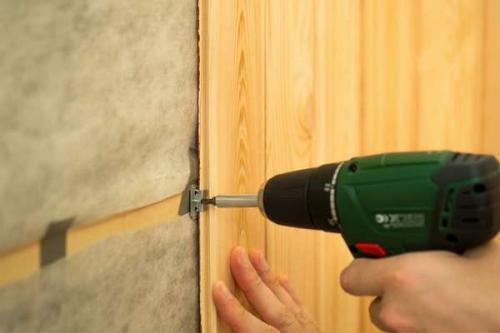
Before fixing MDF panels to wall surfaces, it is worth deciding on their pros and cons. The benefits include:
- Simple and convenient installation. Fastening of MDF panels to the wall is carried out using a frame. It can be either horizontal or vertical.
- Excellent sound insulation.
- A wide range of colors, which allows you to choose the most optimal option in a particular case.
- Attractive appearance.
- Easy to care for. It is enough just to wipe the surface with a damp sponge.
- Affordable cost.
Also, this material is characterized by the presence of certain disadvantages. The walls are hollow under the panels. That is why, if there is a need for fastening any object, it is recommended to use special dowels.
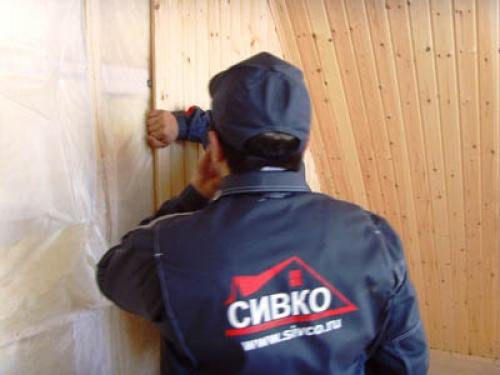 The material is negatively affected by dampness and external influences of a mechanical nature. The material is not resistant to combustion. The panels form an even solid wall.
The material is negatively affected by dampness and external influences of a mechanical nature. The material is not resistant to combustion. The panels form an even solid wall.
That is why grooves are observed at the joints. The use of exterior material is not recommended.
Before fixing MDF panels, it is necessary to correctly approach their choice. In this case, the technical characteristics of the material are taken into account. It is recommended to choose MDF in accordance with certain conditions. In this case, an important factor is the availability of material resources in a person.
Important! Before fixing MDF panels, you need to know their features. This will allow you to finish the room with high quality and for a long time.
Also, the tasks that are planned to be performed using this type of finish are preliminarily determined. First of all, they are determined with the project, which will allow you to choose the most suitable color. In accordance with the characteristics of the room, the material is purchased with a preliminary assessment of its fire and moisture resistance. In order to maintain hygiene standards, it is recommended to use boards with a protective coating.
Folding corner MDF Kronospan
Cut off the corner to the desired size.
We insert a tube with "liquid nails" into the "pistol" (if there is no "pistol", press with whatever is convenient, a bar, a hammer handle, and so on).
We apply glue only to the corner and only in a thin layer.
Then we press the corner tightly against the MDF panel, tightly, but not strongly.
Now we tear off the corner and wait, for about five minutes, the glue will dry a little during this time.
Further, the corner back to the panels, now you can press more strongly and see for a complete fit along the entire length.
Well, in the end, not a big piece of advice: Do not rush to wipe off the excess "liquid nails", wait until the glue dries, then just cut it off, you can use a knife, or you can use a blade.
You won't be able to remove the glue right away, you can't rub the same MDF, break the texture.
The corner is decorative and is fixed in two ways accordingly:
- For glue like "liquid nails". Apply to the entire corner and nestle in the corner.
- For small finishing (without caps) carnations. Carnations are driven through the corner into the MDF panel itself. You can make such nails yourself by biting off the cap. If it is necessary to fix the panel itself together with the corner, then the nail must go through the panel into the crate.




